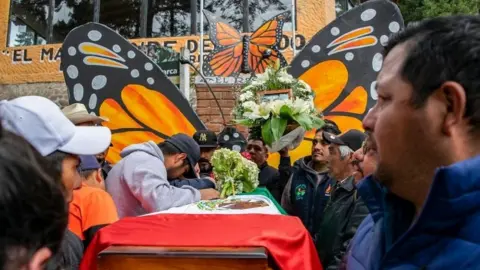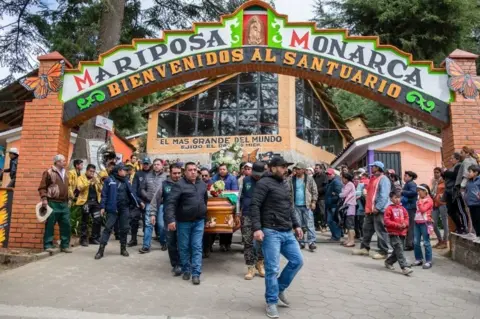Second Mexico monarch butterfly activist found dead
 AFP
AFPA second activist campaigning for the conservation of monarch butterflies and the woods in which they hibernate has been found dead in Mexico.
Raúl Hernández worked as a tour guide at a butterfly sanctuary in Michoacán state.
His body, which bore signs of beatings and a head injury, was found two days after the funeral of Homero Gómez.
Mr Gómez managed a monarch butterfly sanctuary in the same state and had received threats, his family said.
What happened?
Raúl Hernández, 44, disappeared on Monday 27 January. He had left work as usual and was last seen at midday in a village called El Oyamel.
His body was found six days later at the top of a hill in the El Campanario monarch butterfly sanctuary. Forensic experts said his body was covered in bruises and he had a deep wound to his head. An investigation into his death is under way.
Conservationists fear his death may be linked to that of Homero Gómez, who disappeared in the same area on 13 January.
Mr Gómez's body was found in a well on 29 January. His family said that prior to his disappearance, the activist had received threats warning him to stop his campaign against illegal logging.
 AFP
AFPHe was a tireless campaigner for the conservation of the monarch butterfly and the pine and fir forests where it hibernates. The sanctuary he managed opened in November as part of a strategy to stop illegal logging in the area, which is a key habitat for the species.
Officials initially said his body showed no signs of violence, but a post mortem examination revealed he had suffered a blow to the head before drowning in the well.
Mexico's murder rate has risen in recent years and official figures suggest 2019 had the highest rate ever recorded, with 34,582 recorded killings.
Many are believed to be carried out by criminal gangs who kill anyone who could interfere with their illegal activities, which range from drug and human trafficking to extortion, logging and mining.
What's special about the monarch butterfly?
Scientists have been fascinated by the orange and black butterflies because of the vast distances they fly each year to hibernate in Mexico - the longest migration of any insect.
Researchers found that the butterflies use a kind of internal solar compass to guide them during their flight from Canada and the US to the same area on the border between Michoacán and Mexico state every year.
Once they reach the mountain hillsides of the oyamel fir forests in that area, they cluster together to stay warm. Tens of thousands of butterflies can be seen on a single tree, creating a colourful spectacle which has become a draw for tourists.
But environmentalists have warned that illegal logging poses a major risk to these forests and the butterflies which spend the winters here.
